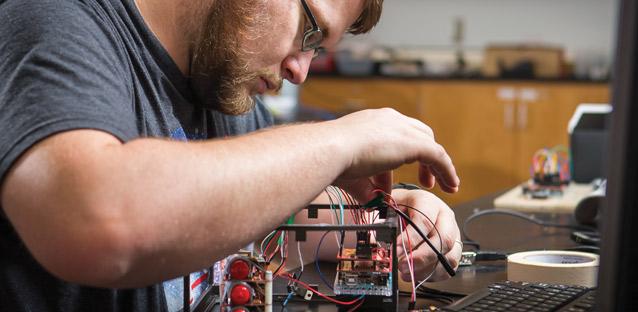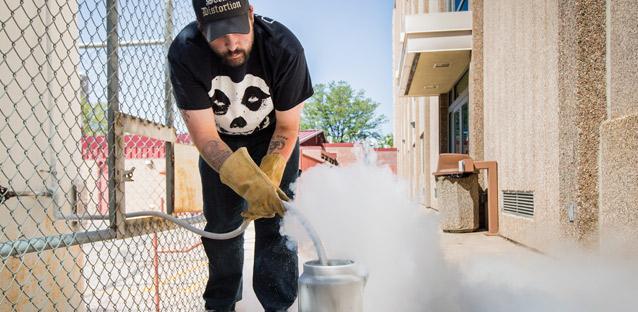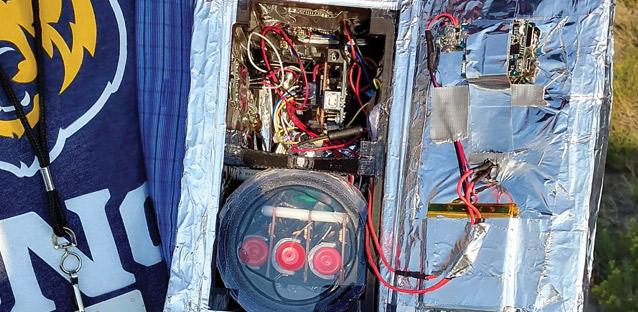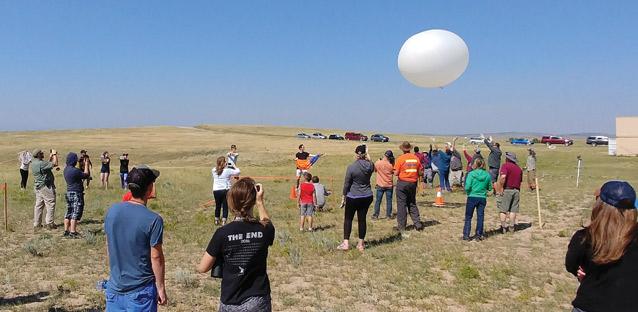When the moon crossed the sun’s path, UNC students were waiting to shed new light on fast-moving muons
By Debbie Pitner Moors
Before fall classes began in August, a hard-and-fast deadline already loomed for UNC seniors Josh Fender, John Ringler and Justin Morse. At precisely 11:46 a.m. Aug. 21, the first day of classes for the semester, the moon and sun would cross paths for a total solar eclipse.
When that moment arrived, their research would intersect with the much-anticipated celestial event. There would be no second chances if their 2.8-pound payload wasn’t aboard a high-altitude balloon launched shortly before the eclipse. The student-led project — more than 18 months in the making — was one of six from Colorado colleges and universities chosen by the NASA-funded Colorado Space Grant Consortium.
“To me, it’s like a child playing with Legos,” says Fender, who plans to teach high school physics. “Anyone can read the instructions and build a kit, but being allowed to create something new, from scratch, meant that we were able to build new connections and discover new ideas that we never would have found had we had our project dictated to us.”
Allowing their students the space to develop the project from start to finish was purposeful, says Assistant Professor Charles Kuehn, who advises the team, along with colleagues Cynthia Galovich, Matthew Semak and Robert Walch. “We try to be as hands-off as possible. We’re there for support for ideas for things like that, but for the most part we really want the (message to) students (to be), ‘This is your thing.’”
Minding their muons
Fender explains that the team had two goals as they designed their project. First, they wanted to build a detector that could study muons at a high altitude. Second, they wanted to create a detector that was inexpensive enough for high school students to repeat the experiment.
So, what exactly are muons (pronounced mew-ons), and why focus on them? Subatomic particles (smaller than atoms), muons are created when radiation from space collides with molecules in Earth’s atmosphere.
To listen to Professor Charles Kuehn talk about solar
eclipses.
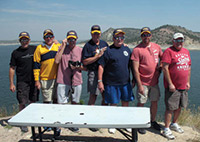
The Eclipse Alumni Reunion
When it came time to plan travel for the 2017 Great American Eclipse, 1973 alumnus Joe Fahey wanted his best Bears with him. Fahey’s trip was more than three decades in the making, since he and fellow alum Clark Bouton witnessed their first total eclipse in 1979. The pair, along with UNC friends John Ricketts, Robb Audette, Jason Moeller and Peter Marcino made the trek from Greeley to Glendo, Wyoming. As a photographer from Apache Junction, Arizona, Fahey captured the reunion and the eclipse in a series of images to share with UNC Magazine. “If you want a life-changing experience, try and get into the path of totality. This will be my fourth eclipse and they still give me shivers!”
“What makes them so interesting,” Fender says, “is that they travel at very close to the speed of light. Interesting things happen to the time and distances observed by both the object moving that fast and those that are moving much slower (us).”
He says the team wanted to isolate the muons from the other types of ionizing radiation. “From everything that we saw, no one else has attempted this at the altitudes our balloons travel to.”
And isolating muons becomes particularly interesting during an eclipse.
“It’s currently believed that most of these cosmic rays (that collide to form muons) are coming from everything besides the sun,” says Ringler. “During the solar eclipse, we’re going to look for a change when there’s line-of-sight blockage of the sun by the moon. Do we get different data than when the sun isn’t blocked? Are most of these cosmic rays coming from outside the sun? That’s what we’re trying to answer.”
Engineering a device that could collect that data — and survive to tell the tale — consumed hours, not only during the prior academic year but over the past summer as well.
“We’ve put in a lot of time to try to figure out how to make this all work and just get reliable data back,” Fender says.
They also had to make it all work on a small budget.
They used Geiger counter technology with a scintillator to detect radiation particles and incorporated a micro SD card to collect data. To protect and surround the device they needed an enclosure — it had to be airtight, lightweight and capable of withstanding the impact of returning to Earth. The team had to ensure the payload stayed under NASA’s required 2.8 pounds, which meant switching from using PVC to a lighter, 3-D printed protective frame. And all of that meant testing, testing — and more testing.
Tests included two launches (one reaching 98,000 feet), as well as vacuum tests of the device’s airtight enclosure to ensure there wouldn’t be electrical shorts as the balloon reached its expected height of about 100,000 feet.
They also made several refinements to the enclosure to protect the components from a hard landing. On the way down, the balloon can reach a speed of Mach 1 before the parachute deploys, Fender says.
Each test had its own challenges. In fall 2016, while testing the device’s impact-proof container, Fender and Assistant Professor Semak were working on the Ross Hall roof, totally immersed in their testing. So focused, says Fender, that they weren’t aware that a presidential campaign rally was taking place on campus. Their work on the roof soon drew the attention of Secret Service members in the area, and Fender and Semak found themselves explaining their work to some intensely interested and thorough agents.
Checking, rechecking, testing and re-testing were critical to the project’s viability, and it was close attention to details that Fender says was a memorable part of the project.
“I remember most all of the smaller milestones along the way, like how excited the team was when our sensors worked for the first time. Seeing all of the pieces fit together exactly how we planned. Shaving microseconds off our software run time to give us more accurate data. They all seem kind of silly and trivial, but it was all of the small parts that made the launch successful.”
Launch day and beyond
For most, prepping for the eclipse meant finding a pair of eclipse glasses. For the launch team, it involved long hours (sometimes more than 12 hours daily), intense team problem-solving and hectic testing.
“The night before the launch, I didn't sleep,” Fender says. “I was up all night running
last-minute diagnostic tests and checking to make sure everything was functioning
for the
20th time.”
Exhausted but excited, he and Ringler arrived at the launch site in Guernsey, Wyoming, by 9 a.m. the day before the eclipse. Foremost on their minds was the weather at the site. They knew that if the winds were too strong, the balloon could be blown out of the path of totality.
Denver-based Edge of Space Sciences (EOSS) handled the launch logistics in Guernsey. The UNC payload would be attached to the second of two balloons launched by EOSS the morning of the eclipse.
“Our payload was on the second balloon,” Fender says. “While they were blowing up the first balloon the wind picked up like crazy — so hard that it popped the first balloon.”
EOSS repaired and relaunched the first balloon from a more sheltered location, which led to a 10-minute delay getting the second balloon and its payloads launched. Then, at 10:50 a.m. — a little less than an hour to totality — it was in the air.
“Honestly, ‘Did we turn it on?’ was what I was thinking when we finally launched it,” Fender says.
Once the balloon was in the air and all the chaotic work of recent weeks was out of their hands, they took time to enjoy watching the eclipse.
“It was one of the most beautiful things I have ever witnessed,” Fender says. “As totality approached, the temperature began to drop and the wind picked up even more. About 10 seconds before totality, people started a countdown. When totality occurred, everyone cheered, and we took off the eclipse glasses. We could clearly see the corona and several brighter stars. It was beautiful.”
As eclipse viewers enjoyed the sight, UNC’s device soared above them, recording the eclipse from a whole different perspective. According to EOSS reports, the balloon with UNC’s payload reached an altitude of nearly 96,000 feet, rising at an average of 702 feet per minute. It remained aloft for more than two hours.
“We have our preliminary data back,” Fender reports. “It lines up exactly how we predicted it would. Everything lines up beautifully with our theoretical data.”
Data in hand, the team is compiling results and writing an academic paper. They’ll present their findings at next year’s American Astronomical Society meeting in Denver, and will also publish a how-to guide for high schools and others interested in pursuing such projects on a small budget. (By reusing items, engineering their own pieces and finding inexpensive sources for materials, the team spent about $500 during the course of the project — compared to similar projects that can cost several thousand.)
In the report and the how-to guide, between the lines of a technical how-to and hard data, there’s another lesson for high school students: the pure wonder of designing, exploring and persevering through the steps of scientific research.
“This is the coolest stuff in the world,” Ringler says. “We get to play around with electronics, we get experience doing engineering of electronic and structural circuits, and we get to measure things people haven’t measured before. It’s just doing science.”

